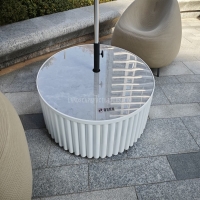Welcome to the website for landscape facilities products and knowledge.
What are the best practices for ensuring proper insulation around electrical components in a landscape bar counter?
Creating a landscape bar counter is an excellent way to enhance outdoor living spaces. However, integrating electrical components like outlets, lighting, and refrigeration requires meticulous attention to insulation and safety to protect against moisture, physical damage, and electrical hazards. Implementing best practices is not just a recommendation; it is a necessity for safety and longevity.
The cornerstone of safe outdoor electrical systems is the use of components rated for exterior use. All electrical boxes, outlets, switches, and fixtures must be specifically designed and labeled for "wet location" or "outdoor use." These are constructed with corrosion-resistant materials and designed to seal out moisture effectively.
Conduit plays a critical role in protecting wiring from physical damage and environmental exposure. For underground feeds to the bar counter, rigid metal conduit (RMC) or schedule 80 PVC conduit is mandatory as per most electrical codes. Above ground, liquid-tight flexible conduit (LFMC) is an excellent choice for its flexibility and waterproof qualities, providing a robust seal between fixed conduit runs and components.
Within the bar structure itself, all connections must be housed within waterproof junction boxes. These boxes have gasketed seals on their covers to prevent water ingress. It is crucial to ensure all conduit connections to these boxes are tight and that any unused openings are sealed with approved plugs. For added protection, apply silicone caulk around conduit entries on the outside of the box.
Perhaps the most critical safety device for any outdoor circuit is a Ground Fault Circuit Interrupter (GFCI). All outlets must be GFCI-protected. This can be achieved by installing a GFCI circuit breaker at the power source or by using GFCI outlets as the first outlet on the circuit, which will then protect downstream outlets. GFCIs are designed to shut off power instantly if they detect a current leak, preventing severe electric shock.
When installing components, elevation is key. Place outlets and junction boxes several inches above the counter surface to avoid direct contact with spilled liquids. Avoid mounting components in the lowest part of the structure where water could pool. Furthermore, use waterproof covers for all outlets, especially those that are not in use.
For insulation and additional protection, spray foam insulation should be used with extreme caution. While it can be used to fill large voids in the bar's framework to prevent air flow and condensation, it must never be sprayed directly onto wires, conduits, or electrical boxes. The heat generated by electrical current needs to dissipate; encapsulating components in foam can trap this heat, creating a fire hazard. Instead, focus on insulating the structure around the electrical runs.
Finally, the entire installation must be performed in strict compliance with the National Electrical Code (NEC) and all local regulations. Given the high risks associated with electricity and water, it is highly advisable to have all work permitted and inspected by a qualified local authority. For complex projects, hiring a licensed electrician ensures the system is safe, code-compliant, and reliably insulated for years of secure operation.
Related search:

Recommendation
Round metal tube border design table with tempered glass or granite countertop on the top.